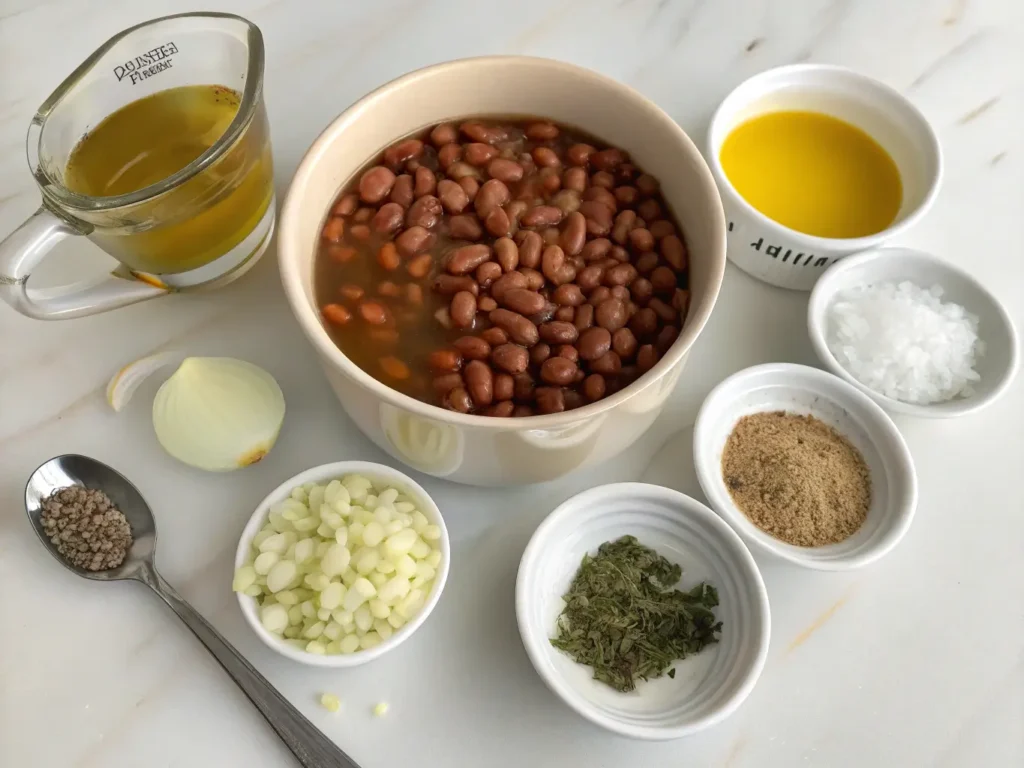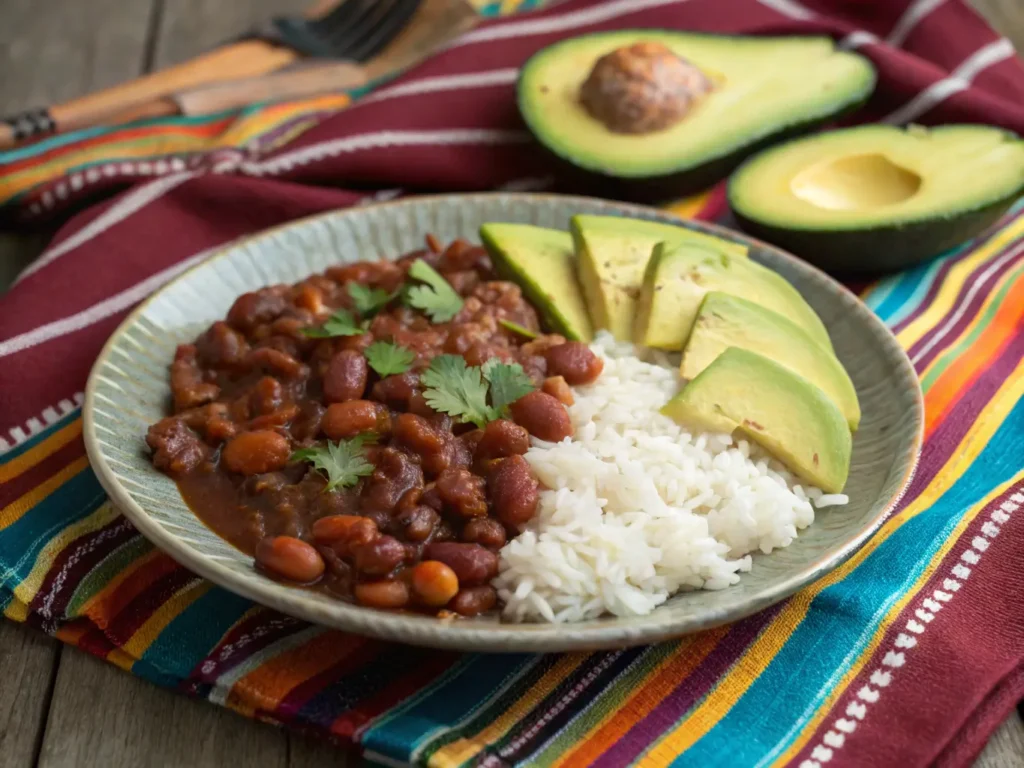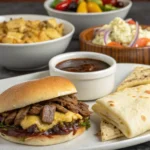If you’re looking for a bean that’s creamy, mild, and packed with nutrients, Peruvian beans are a must try. Known for their smooth texture and golden hue, these beans are popular in Latin American cuisine, especially in Peruvian and Mexican cooking, where they’re often referred to as frijoles peruanos or canary beans.
Whether you’re building a protein rich bowl, preparing a cozy bean stew, or seeking a healthy side dish, Peruvian beans offer a perfect balance of flavor, comfort, and versatility. They pair well with everything from rice and avocado to tortillas and grilled meats and they’re easy to prepare at home with just a few pantry ingredients.
In this guide, we’ll explore:
- What Peruvian beans are
- A traditional ingredient list
- Chef Lucas Benette’s creamy cooking method
- Step by step instructions
- Nutrition facts and tips
- FAQs and easy serving ideas

What Are Peruvian Beans?
Peruvian beans also called canary beans or frijoles peruanos are a type of legume originally cultivated in Peru. They’re prized for their:
- Pale golden color
- Silky, buttery texture
- Mild, nutty flavor
When cooked, they become especially creamy, making them perfect for mashing, blending, or simmering into stews. They’re a popular alternative to pinto or black beans in many Mexican and South American dishes, especially where a smoother, softer finish is desired.
Peruvian beans are:
- Naturally gluten free
- High in protein and fiber
- Easy to digest when soaked properly
- Ideal for vegetarian and vegan meals
Ingredients for Traditional Peruvian Beans Recipe
Cooking Peruvian beans the traditional way is all about simplicity and flavor. You don’t need anything fancy just a few ingredients that bring out the natural creaminess of the beans and allow them to shine.
Here’s what you’ll need for a basic Peruvian style bean recipe that can be served on its own or as a base for other meals.
Main Ingredients:
- 1 cup dried Peruvian beans (canary beans or frijoles peruanos)
- 1 tbsp olive oil or neutral cooking oil
- ½ small yellow onion, finely chopped
- 2 cloves garlic, minced
- 1 tsp ground cumin
- 1 bay leaf
- Salt and pepper, to taste
- 4 cups water or low sodium vegetable broth
Optional Add Ins:
- ¼ tsp turmeric (for color and anti inflammatory benefits)
- A pinch of oregano or thyme
- Chopped cilantro or parsley, for garnish
- Chopped tomato, for brightness and acidity (stirred in at the end)
Ingredient Notes:
- You can soak the beans overnight to reduce cook time and improve digestion.
- For an even creamier result, reserve some of the beans and blend or mash them before stirring back in.

Chef Lucas Benette’s Creamy Bean Cooking Method
Chef Lucas Benette, a culinary pro known for turning simple ingredients into soulful meals, loves working with Peruvian beans because of their natural creaminess and ability to absorb flavor. His method focuses on layering aromatics and gently simmering the beans until they become melt in your mouth soft.
Here’s how he builds his signature creamy Peruvian style beans:
1. Start with a Flavorful Base
“You’re not just cooking beans you’re building flavor from the bottom up.”
Lucas begins by sautéing onions and garlic in olive oil until they’re golden and fragrant. This gives the entire dish a savory backbone.
2. Use Broth Instead of Water
If you want deeper flavor, Chef Lucas recommends using vegetable or chicken broth instead of plain water.
- Low sodium broth prevents the dish from getting too salty
- Add a bay leaf and cumin while the beans simmer to add warmth and earthiness
3. Blend Some of the Beans for Texture
Once the beans are tender, he takes a scoop of the mixture and blends or mashes it before stirring it back in.
“It’s a chef’s trick to thicken the pot without cream or flour.”
This creates a thick, velvety base that still has some whole beans for bite.
4. Don’t Rush the Simmer
Peruvian beans get better the longer they simmer. Keep the heat low and steady, and stir occasionally to prevent sticking. You’ll be rewarded with ultra creamy beans that are never mushy.
How to Cook Peruvian Beans (Step by Step)
Cooking Peruvian beans from scratch is easier than you think. With a few simple ingredients and a little simmer time, you can make a creamy, comforting dish that’s perfect on its own or paired with rice, tacos, or veggies.
Here’s how to make them, start to finish:
Step by Step Instructions
1. Soak the beans (optional but recommended)
- Place 1 cup dried Peruvian beans in a bowl
- Cover with water and soak for 8 hours or overnight
- Drain and rinse before cooking
This helps reduce cook time and improves digestibility.
2. Sauté aromatics
- Heat 1 tbsp olive oil in a large pot over medium heat
- Add ½ chopped onion and cook until soft (about 5 minutes)
- Stir in 2 minced garlic cloves, 1 tsp cumin, and 1 bay leaf
- Cook for 1 more minute, until fragrant
3. Add beans and liquid
- Add soaked beans to the pot
- Pour in 4 cups water or broth
- Bring to a boil, then reduce to a gentle simmer
- Cover and cook for 60–75 minutes, stirring occasionally
Add more liquid as needed to keep beans submerged.
4. Blend for creaminess (optional)
- When beans are tender, scoop out ½ to 1 cup of beans
- Blend or mash, then return to the pot and stir to combine
- Season with salt and pepper to taste
5. Serve hot
- Top with chopped herbs, a squeeze of lime, or a drizzle of olive oil
- Serve with white rice, corn tortillas, or as a base for tacos and bowls
Nutrition & Cooking Tips Table
Peruvian beans aren’t just flavorful they’re also a nutrient powerhouse. Rich in plant based protein, fiber, and essential minerals, they make a perfect staple for anyone looking to eat more wholesome, filling foods.
Here’s a quick look at what you get in one cup of cooked Peruvian beans, plus some must know kitchen tips:
Nutritional Value (1 Cup Cooked)
| Nutrient | Approx. Amount |
|---|---|
| Calories | 200 kcal |
| Protein | 12g |
| Fiber | 8g |
| Fat | 2g |
| Carbohydrates | 35g |
| Iron | ~15% Daily Value |
| Magnesium | ~10% Daily Value |
Cooking & Storage Tips
| Tip | Why It Matters |
|---|---|
| Soak beans overnight | Reduces cook time and improves digestion |
| Use broth instead of water | Adds flavor and depth to the final dish |
| Salt beans only after softening | Early salting can toughen bean skins |
| Mash or blend a portion | Creates a naturally creamy texture without dairy |
| Store with cooking liquid | Keeps beans moist and flavorful in the fridge |
| Refrigerate leftovers | Store in airtight containers for up to 4–5 days |
| Freeze for later | Beans freeze well in broth for up to 2 months |
Bonus Tip: Want to cut prep time? Cook a large batch and freeze in individual portions to use for bowls, soups, or tacos all week long.
FAQs About Peruvian Beans
1. What are Peruvian beans called?
Peruvian beans are also known as canary beans or frijoles peruanos. In Latin America, especially in Mexico and Peru, they’re a staple legume used in creamy soups, stews, and side dishes. They get their name from their pale yellow color, which resembles that of a canary bird.
2. Are Peruvian beans the same as pinto beans?
No, they’re not the same though they are similar. Peruvian beans are creamier and lighter in color than pinto beans, which are tan with brown speckles. Pinto beans have a slightly earthier taste, while Peruvian beans are known for their milder flavor and smoother texture when cooked.
3. What is a substitute for Peruvian beans?
If you can’t find Peruvian beans, good substitutes include:
- Pinto beans
- White navy beans
- Great northern beans
These options have similar cooking properties, though the texture and flavor may vary slightly. For best results, aim for creamy, soft cooking beans.
4. What are Peruvian beans good for?
Peruvian beans are incredibly versatile. They’re great in:
- Soups and stews
- Rice and bean dishes
- Burritos, tacos, and bowls
- Bean dips or spreads
They’re also high in plant based protein, fiber, and key nutrients like iron and magnesium, making them ideal for vegetarian and heart healthy diets.
Final Thoughts on Cooking with Peruvian Beans
Peruvian beans are a delicious, versatile, and nutrient packed legume that belongs in every kitchen. Whether you’re making a classic Latin side dish, a vegetarian main, or simply swapping them into your favorite recipes, their buttery texture and gentle flavor make them a true crowd pleaser.
Thanks to Chef Lucas Benette’s slow simmered technique, you can turn a bag of dried beans into something rich, creamy, and comforting with just a few simple ingredients.
Try them with:
- White rice and avocado slices
- As a filling for tacos or burritos
- Topped with fresh herbs and lime juice
- Or blended into a smooth bean dip or soup base





